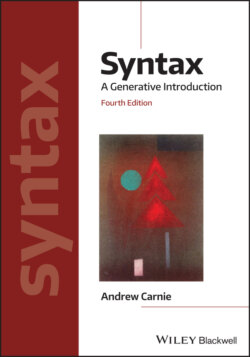Читать книгу Syntax - Andrew Carnie - Страница 24
8. THE SCIENTIFIC METHOD AND THE STRUCTURE OF THIS TEXTBOOK
ОглавлениеThroughout this chapter I’ve emphasized the importance of the scientific method to the study of syntax. It’s worth noting that we’re not only going to apply this principle to small problems or specific rules, but we’ll also apply it in a more global way. This principle is in part a guide to the way in which the rest of this book is structured.
In chapters 2–5 (the remainder of Part 1 of the book) we’re going to develop an initial hypothesis about the way in which syntactic rules are formed. These are the phrase structure rules (PSRs). Chapters 2 and 3 examine the words these rules use, the form of the rules, and the structures they generate. Chapters 4 and 5 look at ways we can detail the structure of the trees formed by the PSRs.
In chapters 6–9 (Part 2 of the book), we examine some data that present problems for the simple grammar presented in Part 1. When faced withmore complicated data, we revise our hypotheses, and this is precisely what we do. We develop a special refined kind of PSR known as an X-bar rule. X-bar rules are still phrase structure rules, but they offer a more sophisticated way of looking at trees. This more sophisticated version also needs an additional constraint known as the “theta criterion”, which is the focus of chapter 8.
In chapters 10–13 (Part 3) we consider even more data, and refine our hypothesis once again, this time adding a new rule type: the transformation (we retain X-bar, but enrich it with transformations). Part 4 of the book (chapters 14–18) refines these proposals even further.
With each step we build upon our initial hypothesis, just as the scientific method tells us to. I’ve been teaching with this proposal–then-revision method of theory construction for a couple of years now, and every now and then I hear the complaint from a student that we should just start with the final answer (i.e. the revised hypotheses found in the later chapters in the book). Why bother learning all this “other” “wrong” stuff? Why should we bother learning phrase structure rules? Why don’t we just jump straight into X-bar theory? Well, in principle, I could have constructed a book like that, but then you, the student, wouldn’t understand why things are the way they are in the latter chapters. The theory would appear to be unmotivated, and you wouldn’t understand what the technology actually does. By proposing a simple hypothesis early on in the initial chapters, and then refining and revising it, building new ideas onto old ones, you not only get an understanding of the motivations for and inner workings of our theoretical premises, but you get practice in working like a real linguist. Professional linguists, like all scientists, work from a set of simple hypotheses and revise them in light of predictions made by the hypotheses. The earlier versions of the theory aren’t “wrong” so much as they need refinement and revision. These early versions represent the foundations out of which the rest of the theory has been built. This is simply how science works.
